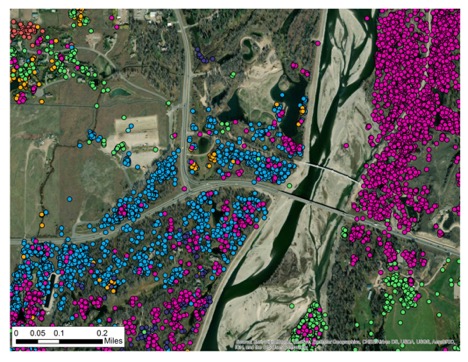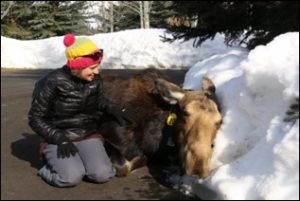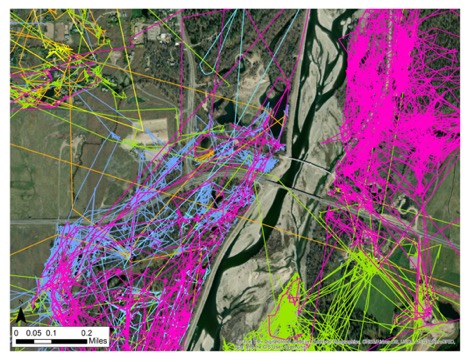By Aly Courtemanch, Wildlife Biologist | Wyoming Game and Fish Department

Collared moose GPS locations in the vicinity of the Snake River Bridge and Highway 22/390 intersection from March 2019 – January 2020. Each color corresponds to an individual collared moose. The GPS collars collect a point every 30 minutes.
Moose are one of the most beloved wildlife species by our community. During the winter, they become more easily observable when they migrate down to low elevations and are often seen right in our neighborhoods and backyards. However, living amongst humans and our development can be dangerous too. The number of moose-vehicle collisions on roads have steadily increased in recent years in Teton County.
For this reason, the Wyoming Department of Transportation and Wyoming Game and Fish Department partnered in 2019 to learn more about when, where, and how often moose cross roads. In March 2019, we darted 10 cow moose within 3 miles of the Snake River Bridge and Highway 22/390 intersection and fit them with satellite tracking collars. These collars are programmed to collect a GPS location every 30 minutes and will stay on the moose for 2 ½ years, at which point they will automatically detach and drop off. The collars upload their GPS locations every 2 days to a satellite, which then sends the locations to an email account where we can download them. This technology allows us to get real-time data on moose movements and be alerted to possible mortalities.

Kate Gersh, Associate Director Jackson Hole Wildlife Foundation, sits with an anaesthetized cow moose while she wakes up.
This is the first time that moose have been collared in this area so we are learning new and very interesting things about their movements. We have learned that four of the 10 moose are migratory, meaning that they moved from their low elevation winter ranges where they were collared to high elevation summer ranges. One of the collared moose spent the summer in Grand Teton National Park in Open Canyon and Death Canyon. The other migratory moose spent the summer in Phillips Canyon and Teton Pass. Six of the 10 moose are resident, meaning that they used generally the same areas in the summer and the winter. Resident moose mostly spent the summer on West Gros Ventre Butte, around the Wilson area, and along the Snake River, Fish Creek, and Fall Creek.
We have also learned that some moose cross roads a lot, whereas others cross very infrequently. Two moose have only crossed Highway 22 or 390 once or twice during the past 10 months. Other moose have crossed 27, 34, and 67 times! So far, only one collared moose has died. She died of unknown causes but had not crossed any roads while she was collared, so her death was not caused by a vehicle collision. The moose collar data has already provided important information about where wildlife underpasses should be located as part of WYDOT’s Snake River Bridge replacement project, which is expected to start construction in 2022.

Collared moose movements in the vicinity of the Snake River Bridge and Highway 22/390 intersection from March 2019 – January 2020. Each color corresponds to an individual collared moose. The lines shown on this map connect the 30 minutes points seen on the previous map.
This project has received a HUGE amount of support from our community! In addition, many new funding partners have contributed money this year to expand this study. Thanks to this help, we plan to dart and collar eight more cow moose in March 2020 and partner with other researchers to study how diseases and parasites (winter ticks) are affecting moose.
I want to extend a huge thank you to all of the private landowners who allowed us access to their property to dart and collar these moose! Thank you to our funding partners: Wyoming Department of Transportation, Teton Conservation District, Greater Yellowstone Coalition, U.S. Geological Survey, Teton County, and Veterinary Initiative for Endangered Wildlife.
